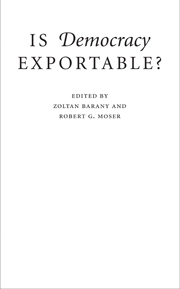Book contents
- Frontmatter
- Contents
- Contributors
- Acknowledgments
- Introduction
- A MORAL IMPERATIVE?
- STRUCTURAL PRECONDITIONS
- INSTITUTIONS AND PROCESSES
- 6 Electoral Engineering in New Democracies: Can Preferred Electoral Outcomes Be Engineered?
- 7 Does It Matter How a Constitution Is Created?
- 8 Building Democratic Armies
- 9 Democratization, Conflict, and Trade
- 10 Exporting Democracy: Does It Work?
- Conclusion: Is Democracy Exportable?
- Bibliography
- Index
7 - Does It Matter How a Constitution Is Created?
Published online by Cambridge University Press: 05 June 2012
- Frontmatter
- Contents
- Contributors
- Acknowledgments
- Introduction
- A MORAL IMPERATIVE?
- STRUCTURAL PRECONDITIONS
- INSTITUTIONS AND PROCESSES
- 6 Electoral Engineering in New Democracies: Can Preferred Electoral Outcomes Be Engineered?
- 7 Does It Matter How a Constitution Is Created?
- 8 Building Democratic Armies
- 9 Democratization, Conflict, and Trade
- 10 Exporting Democracy: Does It Work?
- Conclusion: Is Democracy Exportable?
- Bibliography
- Index
Summary
CONSTITUTIONAL MOMENTS
The world is witnessing a boom in constitution writing. A comprehensive study of the birth and death of national constitutions counts 736 written and promulgated from 1789–2005, or about three-and-a-half per year (Elkins, Ginsburg, and Melton 2006). Another worldwide study of constitutional adoption tallies nearly 200 new national charters just from 1975–2005, or closer to seven per year (Widner 2006). Some of these constitutions endure for long periods, their provisions widely respected in practice, and they come to embody in parchment the formal rules of political competition and policymaking in their respective states. Most have shorter, less distinguished tenures.
Constitutional moments are diverse. Some new constitutions are born in the wake of war, some coincide with the establishment of democracy or its collapse, some with the redefinition of national boundaries or the foundation of new states. Others accompany less radical changes and are adopted according to procedures established by a prior constitution. The actors involved and the procedures that characterize constitutional moments also vary. Some new charters are drawn up by small groups, perhaps advisers to a chief executive, whereas others are drafted by national assemblies or conferences including hundreds of participants. Participants are democratically elected in some cases, but not others. Many new constitutions must be ratified by popular vote to take effect, but not all.
The modern surge in constitutional moments presents the questions: Does it matter how constitutions are drafted and adopted? What are the ideals toward which constitutions might contribute?
- Type
- Chapter
- Information
- Is Democracy Exportable? , pp. 155 - 177Publisher: Cambridge University PressPrint publication year: 2009
- 25
- Cited by



